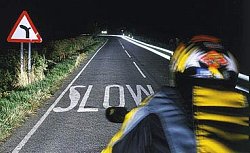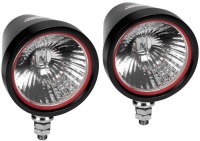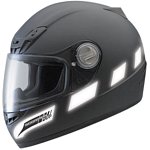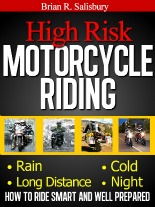Sign up today to get your FREE newsletter and BONUS info!
Riding a Motorcycle at Night?
Prep Yourself
and Your Bike to Stay Safe After Dark
Riding a motorcycle at night comes with the territory when you travel on two wheels.
It can be an exhilarating and enjoyable experience when you and your motorcycle are prepared and you know how to handle riding in the dark.
Sure, I bet most of us feel more secure and less concerned about the road and our surroundings when riding in bright sunlight. But sometimes we can't avoid night riding.
If you enjoy riding a motorcycle at night and take it in stride, or you only ride after dark when you must, here's info to help you to ride safely and confidently when the sun goes down…
Why ride at night?
If you have a choice, why should you be riding a motorcycle at night at all?
Here's why…
Riding a motorcycle at night offers an entirely different kind of enjoyment than anything you'll experience during the day. This is especially true when cruising on unlit country roads after dark.
Here your world and your focus becomes the narrow portion of road and nearby landscape illuminated by your headlight.
Your motorcycle's handling qualities and your ability to anticipate, observe and respond to the road and your surroundings take on heightened importance within this limited nighttime universe.
You sense and smell -- rather than see -- your surroundings. For example, you feel the damp cool air when passing lakes and ponds, and smell the grass when passing fields.
Riding a motorcycle at night can concentrate all of the satisfying qualities of the entire motorcycling experience.
But night riding can be dangerous...
And the biggest danger is a rider's inability to see and be seen.
A glimmer in the tall grass ahead can be the reflection of your headlight on a fox's eyes or just a glint from broken glass. You must remain on guard for big and small animals darting across your path or simply standing in the middle of the road.
Here are ways you can remedy visibility issues and manage other concerns when riding a motorcycle at night...
Upgrade your motorcycle's lighting
Having good lights -- front and rear -- are critical when it comes to riding a motorcycle at night as safely as possible.
For starters, it's a good idea to make sure your headlight is aimed high enough to reach out as far as your state law allows.
Next, if you have wimpy lights or you simply want to pump out as much illumination as your bike's electrical system allows, consider at least replacing your bike's bulbs with more powerful versions.
You can upgrade your existing bulbs with brighter, similar wattage replacements. And you can consider upgrading the wattage or type of bulb as well.
When upgrading bulbs, make sure your bike's electrical system can handle the load without damaging your wiring, the on-off switch or plastic headlight lens. You don’t want to over-tax your alternator, either.
Another option -- especially if you're frequently riding a motorcycle at night on unlit back roads -- is to add a set of auxiliary lights that really brighten your path.
In addition to illuminating the road, a set of auxiliary lights makes your bike stand out more prominently than a motorcycle equipped with a single headlight.
If you decide to equip your bike with high powered torches, please be kind to other drivers. Lower your lights when behind the other guy or heading directly at him.
Increase your visibility so other drivers see you when riding a motorcycle at night
Increasing your visibility, no matter how you do it, is always a good idea.
- Add lights to your bike
As mentioned, adding a dual-running set of headlights to your motorcycle will make you and your bike much more noticeable to oncoming traffic than can a single headlight.
Another advantage of dual or auxiliary headlights is they help to identify you sooner as a motorcycle rather than a car with one blown headlight.
And make sure your tail light works, and that it's large enough and bright enough to be seen easily. - Add reflective tape to your bike
Apply reflective tape to surfaces on you bike that typically are illuminated by other motorists' headlights, such as the backs of your saddlebags, your tail bag and rear fender.
- Add reflective material to your clothes
Apply reflective tape or reflective material to your riding gear and clothing -- especially if your gear is black or another dark color -- including red.
For example, wrap a reflective arm band around each jacket sleeve or a longer reflective band around the bottom of each leg.
Or wear a high visibility reflective vest.
- Make your helmet stand out at night
Apply reflective tape on the front, back and sides of your helmet to catch light beams from headlights and street lamps.
Make sure you can see clearly
After you've gone the extra mile to make sure other drivers can see you, make sure you can see them.
Keep your eye protection clear and clean.
Use a soft, wet cloth on your faceshield and windshield before you head off into the night. Dirt on either will reflect the light and distort your vision.
And replace a scratched faceshield. It can ruin you ability to see clearly -- especially when the light from other drivers' headlights bounces off the scratches when you're motorcycle riding at night.
parts and accessories to make you and your
motorcycle easier to see at night…
Use other vehicles' headlights to your advantage
While you should keep a safe distance between you and the car in front, you can use that car's headlights to help you see the road ahead when riding a motorcycle at night.
And a car's lights will warn you of that car's approach from the opposite direction. This is especially useful on winding roads when you can see the light hitting the road, trees and overhead power lines long before you can see the car itself.
Drive defensively
Before you turn or pass, flash your headlight, turn on your blinker and even blow your horn to make sure vehicles traveling in each direction see you.
And even if you think other vehicles see you, drive as if they don't.
- Always give yourself plenty of room
Leave lots of room in all directions so you can respond smoothly to other vehicles' actions. This is especially true when you're passing or turning.
You want enough time and space to react if a vehicle acts unexpectedly.
Pass fast. Never hover in a driver's blind spot. - Pick the safest lane position
And don't ride in any vehicle's rear blind spot -- such as directly behind a large truck. If you can't see either of a truck driver's mirrors, that driver can't see you.
Whenever possible and practical, ride near the center of the lane; but not in the exact center because that's often covered with oil.
Another reason why you shouldn’t ride in the exact center becomes obvious when the vehicle ahead passes over something in the road.
Chances are the object will emerge from under the vehicle's middle-rear. You don't want to see a dead raccoon or kitchen sink for the first time when either appears directly in your path.
Also avoid riding too close to the edge of the road where there are just too many rocks, bottles, potholes, unpredictable animals and other obstacles to run over.
Mind your speed
Observe posted speed limits.
Riding a motorcycle at night will limit the distance you can see and the quality of your vision.
You don't want to outrun your headlight's ability to illuminate the road ahead and give you a clear view of potential dangers -- especially if you're on a dark country road.
Plus, you don't want a speeding ticket. It's easy for troopers to park where you can't see them in the dark.
Watch out for animals on four legs and two legs
Wild animals, big and small, are most active between dusk and dawn -- especially deer.
Continually scan the road as far ahead as possible to spot shiny eyes or movement so you can slow down or otherwise avoid an accident.
And be aware of half-asleep, inebriated and/or otherwise distracted and dangerous two-legged animals walking or driving.
One may wander onto the road or try to overtake you from behind.
Maintain your personal comfort--wear the right clothes
Be ready if the temperature drops so you're not distracted by driving cold and uncomfortable when riding a motorcycle at night.
Dress immediately before heading out or pack extra clothes to keep you warm if the night gets chilly.
Rest when you must
If you start losing your focus, stop and take a break.
It's easy to become inattentive when you're droning along the highway and just logging on miles to reach your destination.
What you want to avoid at all costs is to nod off while driving.
A warning that you're getting dangerously tired is when you realize you've been driving for some distance and can't remember anything about it. Another warning is when you find yourself changing speeds -- usually going slower -- for no reason.
Once you start nodding off, no amount of coffee or jumping jacks or cold water in the face can stop it.
It's time for at least a nap. If you're really weary, find a motel and get some serious sleep.
Plan ahead
Before you head out on the road to go motorcycle riding at night…
- Prep your stuff
Give all the important night-fighting stuff a good cleaning -- your headlight, taillight, signals, windshield and helmet visor.
Make sure your faceshield is scratch free. - Decide how fast and how far you want to ride
If you'd rather not ride at night, plan ahead.
How much do you want to ride each day -- how many miles and how many hours? Have some idea where you can stop when you reach either limit.
If you don't make reservations, give yourself enough time and daylight at the end of your riding day to find a place to stay.
It's always a nuisance to have to jump on and off of the highway or ride in and out of motels to find one that works for you. But it's even more of a bother to search after dark.
If you plan on camping out, find a place to pitch your tent well before the sun goes down. If you want to stay at a commercial or state-run campground, find one early in the afternoon before all the good spots are taken.
When you know the hazards associated with riding a motorcycle at night and you do everything possible to make your cruise safe and comfortable, riding at night can be a unique and enjoyable experience.
But don't leave your safety to chance. Anticipate conditions and situations.
parts and accessories to make you and your
motorcycle easier to see at night…
Want to be better prepared to deal with high-risk motorcycle riding situations?
Increase your motorcycle driving skills and confidence when…
· Riding at night…
· Riding in the rain…
· Riding in cold weather…
· Riding across long distances…
You'll find a wealth of effective motorcycle driving and control tips and techniques for challenging situations -- and more -- in my book "High Risk Motorcycle Riding."
Click here for more information about what you'll find in this revealing book and where to zero-in on a copy for yourself…
Return from Motorcycle Riding at Night to
Let's stay in touch!
Get your free subscription to..."Savvy Motorcyclist E-zine"
And you'll also receive your free copies of...“The 10 Best Motorcycle Travel and Trip Planning Websites on the Internet” ... plus the Motorcycle Safety Foundation’s 58-page Motorcycle Operator’s Manual.
These great resources will help you to ride better, plan your trips, enjoy the best motorcycle roads and get the most out of motorcycle riding.






